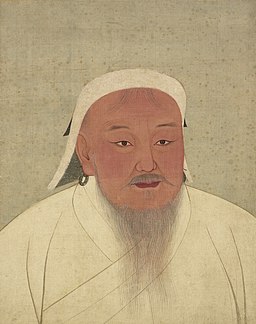By Clark Zlotchew
Genghiz Khan, Humanitarian, by Sukhbaatar Arhangbai (adequately translated into English by Ulan Bulgan Jones. 486 pages. Paintings and photographs by Bayanhongor Dzavhan & René LaRochelle. Hard cover 56 Euros. Paper 27 Euros.
New light has been shed on the oft-maligned Genghis Khan in this beautifully-illustrated book, With regard to the personal history of the Khan, whose original name was Temujin, as well as the narration of his military campaigns and conquests, the narration does not differ essentially from the many histories of the first Mongol Emperor that have been in print for the last two-hundred years. What is different, however, about this innovative tome is the tone, plus the introduction of little-known incidents in the life of the great Unifier of Peoples, as Arhangbai calls him, and the benevolent attitude of this brave warrior toward humanity.
Genghis Khan forged the largest land-based empire that has ever appeared on earth. In a time in which no automotive vehicles existed and certainly no airplanes. The territory was conquered by his Mongol warriors on horseback. His warriors were fierce in battle, but, Mr. Arhangbai insists, were good to their mothers and their horses. Unfortunately, Kim does not provide documentary evidence of this claim, but he seems to this reviewer an honest and trustworthy scholar.
An interesting facet of this welcome book is the description of some of the popular culture of the nomadic tribes that formed the original horde between the Gobi Desert on the south and Lake Baikal on the north. Wrestling matches were an extremely popular spectator sport as well as a participatory sport among the non-professionals, practiced at picnics, throat-singing entertainments, weddings and coming-of-age celebrations. This latter subject deserves a paragraph of its own.
A male child goes through rigorous training in wrestling from the age of eight on. In addition to horsemanship, swordplay and archery. At the age of twelve he must prove his manhood by singing, with correct diction, pitch perfect throat rendition of their tribal anthem, “I will slay Siberian Tigers and Eat Their livers, Then I Will Come for You.” He must then wrestle to the death a captive of approximately the same age and weight. (If the captive wins, he must dig the grave and bury his opponent; he then is given Mongolian citizenship, becomes one of the warriors and trained to fight.)
On the other hand, if the native twelve-year-old slays his opponent, whose corpse is left for the vultures, he must then select “the Perfect One” (an unmarried female captive within the age range of seven to eighteen) wrestle her into submission, i.e., when she cries “Master, I am yours!” at which point he must cease causing her pain. At this juncture Genghis himself marries them and provides groom and bride with new clothing. The Khan then carries out what the “more civilized” Western nations of the same era referred to as the droit du seigneur or jus prima nocte, in the same space in which the wrestling matches took place, to the admiration and raucous cheering of the merry throng. (The author makes clear, in context, that the “more civilized” term is used ironically.)
Mr. Arhangbai states that this Mongol custom is morally superior to the Western practice because, “The Western noble performed this duty in the privacy of his own bedchamber, as though it were a dirty, shameful act that must be concealed from all others, whereas the Mongol custom carries this joyful and honor-conferring act of love in public so all could share in the honest joy of the occasion.”
At this point the slaying of sufficient numbers of sheep and goats takes place with solemnity, swords are used as spits to roast them over huge fires, after which shashlik is enjoyed accompanied by mountains of rice (the original pilaf) by the guests. Many gallons of fermented mare’s milk are consumed at this feast.
Arhangbai’s descriptions of selected battles are indeed exciting and, according to the author, illustrative of the Khan’s magnanimity and beneficence. As one example, he provides the battle of Baghdad. The Mongols laid siege to the city at a period in which the Plague infected and killed many of the besiegers. Knowing that the disease was easily transmitted from person to person, they determined to remove the corpses far from camp by catapulting them over the walls of Baghdad. Arhangbai insists that this salutary method accomplished two tasks simultaneously: it removed the pestilence from the Khan’s ranks, thereby preserving life, while at the same time, the disease laid low many defenders of this great city, forcing them to surrender. This surrender saved untold numbers of the Khan’s men.
Upon entering the conquered city, the Mongols slew the dying, thereby saving them the horror of the painful death caused by the Bubonic Plague. Strangely, all the men aged fifteen and up were, according to the Khan’s personal historian, infected, therefore were put to the sword to save further contamination and, again, to spare the victims the agonies of the horrible slow death caused by the disease. All the females from new-born babies up to the age of twenty who seemed healthy were rescued from this contaminated city by the Khan’s men, and those above the age of twelve were given the honor of being married to the members of the Horde. The children were saved and taken care of for the time they reached marriageable age. In each marriage, Genghiz Khan blessed them and gave them honor by the practice of jus prima nocte. Another example of the Khan’s magnanimity, according to the author.
From these examples, the author states that he has “proven, beyond the shadow of a doubt,” that Genghiz Khan, who has been maligned for centuries by ill-informed and/or malicious historians, was not only a great warrior, but a kindly and benevolent ruler. Even more so than Attila the Hun. (Strangely, I believe, is the author’s suggestion that the title Khan is another form of the family names, Kahn, Kohn, Kahan, Kagan, Kaganovich, Kohan, Kohen, Cohan and Cohen. The reader will decide if this has any scientific truth to it, or is something the author simply dreamed up. No reliable historical or linguistic evidence is adduced for this in the book.)
The writer of this review urges both historians and the lay reader to acquire a copy of this cutting-edge historical masterpiece, in order to see the glory that was the Empire of Genghiz Khan.
Clark Zlotchew is SUNY Distinguished Teaching Professor of Spanish and literature in Spanish language, Emeritus. Only three of Zlotchew’s 17 books consist of his fiction: Two espionage/thriller novels and an award-winning collection of his short stories. Newer work of his has appeared in literary journals of the U.S., U.K., Australia, Canada, Germany, South Africa and Ireland from 2016 through 2020. www.clarkzlotchew.com







Be First to Comment